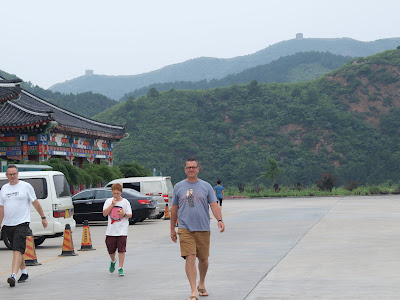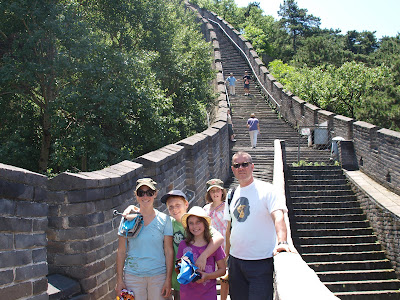Our last morning in Xi’an was dampened by the pouring rain but we decided to head out all the same, exploring the narrow streets around the hotel. The girls had their nails painted by a lovely young thing who didn’t speak or understand a word of English. How do you say French manicure in Mandarin? I ended up doing a little colour-coded drawing and then watched her exchange sweet smiles with the girls.
We’d been seeing people carrying these little sandwiches in plastic bags for days and were hell-bent on finding them before leaving Xi’an. With five minutes ‘til our bus left we finally found them. Little round pucks of bread stuffed with pulled beef, hoisin sauce and spring onions. Yummy.
Back to Hong Kong and our heavenly quarters there. We took it easy and went out to dinner at Chez Patrick, a meal that put to rest any doubts about getting amazing french food in Hong Kong. We were treated like royalty. Patrick came out and chatted before wowing us in the kitchen. His wife, the pastry chef, emerged before her course and very shyly talked to us about what she’d whipped up.
At every opportunity Abby shows us a new dim sum restaurant. I think she has managed to cover the entire finger-licking range of Chinese cuisine in her ordering. There is always a great deal of shifting around as we try to find room on the lazy susan for all the amazing dishes.
Feeling like the horseshoe is very firmly planted, on wednesday we head down to the ferry piers at noon. Waiting for us is a yacht, and not just any yacht. We are joined by Abby’s good friend, Phoebe, Abby’s two sisters Ida and Cindy, Ida’s husband Kenneth, Cindy’s daughters Annabel and Gigi and their respective boyfriends Fred and Joe. What an amazing group of people. After a few bottles of wine, the Cantonese was coming fast and furious and it was strange (and wonderful) feeling so totally included without understanding a single word. We motored through the harbour, competing with container ships the size of small towns, teeny sampans swaying like teeter-totters, overpowered jetfoils and catamarans zipping by on their way to and from Macau, and ferries hauling people to one of the hundred outlying islands. We broke through the traffic and made it around to Stanley, anchoring just off the coast from a minimum-security prison that was built to house British soldiers during the Japanese occupation. There was one other boat in the inlet, filled with young Hong Kongers having a party on the South China Sea. While James good-naturedly saved the financial world from what I feel was a very poorly-timed dip, the kids had a blast banana-boating around the harbour.
We got to know Abby’s family as we listened to mellow tunes (one of the huge perks of hanging out with two djs is the always perfect soundtrack) and wandered from lounge area to lounge area wine glass in hand, with the occasional dip in the refreshing water. Every minute or two I pinched myself wondering just how I ended up so damn lucky.
In the late afternoon, we went on to Lamma and got dropped off for dinner on the island. We walked through a long strip of restaurants, each with its own little highrise of aquariums filled with bubbling water and every sea creature known to man. Ida steered us into the last one on the strip, the hilariously named “Hilton”, where we chatted and drank some more overlooking the harbour. Out came the dishes. Abby and Ida make a mean meal-ordering team. The ever-present fried rice for Alistair, langoustines, lobster split length-wise served with a cheese & onion sauce on noodles, massive steamed shrimp, scallops, garoupa, amazing mini-clams in black bean sauce, barbecued chicken, garlicky greens and lots of little dipping bowls of vinegar, oyster sauce, chili sauce. The wine continued to flow.
Back to the boat for a speedy return to Hong Kong Harbour in time for the eight o’clock laser show. All the lights of a hundred highrises controlled centrally for maximum effect. It’s a spectacular show and all the more impressive lying on one’s back on a yacht bobbing in the bay.
Our last full day in Hong Kong we were back at the terminal and jumped on a ferry to Cheung Chau full of families and teenagers on summer holiday, off to enjoy a day out of the metropolis. Less than an hour later, we pulled into the tight harbour—sampans and junks, fishing boats and dragon boats all competing for space. Some of the smaller vessels, draped with yards of sun-faded fabric, were obviously home for some of the locals.
We rented bikes, a three-wheeler with an awning and a double seat for Wil and the girls while Henri and I got our own two-wheelers (after crashing our three-wheeler into a few too many walls). 35 degrees and not a lick of shade. All the buildings no more than three stories high, which was a a welcome change from the endless skycrapers and elusive sky of Hong Kong. With no motorized vehicles on the island, save a very small ambulance, the foot and bike traffic was intense. We wheeled around and watched giggly teenagers taking turns pulling each other around, kids in uniform cycling home from school and old men transporting their wares across the island, standing astride their bikes and pushing their feet along the ground. Many of the adults’ bikes were kitted out with training wheels. We did the tour of the south part of the island and then dropped the bikes back off at the rental stand. We cross edover to the other side to find one of the island’s beaches, a rectangle of sandy shore and water roped off with buoys. Fishermen in tiny boats ply the waters just beyond the floats. Packs of kids stand knee deep in the water and pose for endless photos, couples lounge under parasols. The lifeguards strut and pose self-importantly. Three round steel rafts float a few hundred metres out. Henri, Frances and I swim out. I realize once we’re out above head level that no one else is. No one knows how to swim.
The kids ate potatoes cut in spirals which were deep fried on skewers. Other people ate ping pong fish balls or chomped on frozen chunks of colourful fruit kebabs. Every little nook of every narrow alley is a stall or a restaurant or a store. The ferry back was an eye-opener. The upper deck was full of young teenagers coming back from a fun day on the island. We shared our table with a few girls who behaved like all teenagers — alternating between looking very bored or sleepy and super animated as they flit about, chatting with their pals at other tables. A very pretty group of girls amid a gang of gangly boys. It took me half the ride to figure out why they all looked so gorgeous. Not a drop of makeup on any of them. In North America, perhaps in Europe too, they would be walking advertisements for every makeup manufacturer. Not so for teenagers in Hong Kong — no lip gloss, no mascara, no foundation, just a bunch of very naturally pretty young things. A welcome change from the kids at home who perhaps don’t realize they’re gilding the lily.
We walked back through Central, avoiding all the trams and traffic on the elevated walkways — a boon in the rainy season and also in today’s scorching sun. We hop back on the MTR out to Chai Wan to visit Abby’s Pure Art Foundation headquarters and studio. Two beautiful, raw redecorated spaces in industrial buildings overlooking what appeared to be the recycling triage centre of Hong Kong. The kids were whisked off by Marietha and Robert to visit with sister Cindy and her eleven dogs and we went on to meet James at Zuma, following Abby through a maze of malls and walkways, never setting foot into the hazy heat of Central. We emerged from an elevator into a space that is all glass and tile. Sky high walls of wine, beautiful waitstaff bring us rough ceramic platters and plates stacked with elegantly displayed sashimi and sushi and uni.
Wil and I spend our last morning like our first in Hong Kong, scaling the steep hill behind Hong Lok Yuen. The stairs go up and up the hillside, the handrails a homemade confection of vacuum piping and recycled metal. We climb and climb, the hangover and the heavy, humid air leave us gasping. Everyone we cross greets us with a very jolly “Djo san!” We huff and puff our way up the endless stairs, feeling very virtuous and even more unfit. At the top we find a foursome of retired folk who obviously don’t share our opinion that the ascent is exercise enough. They’re busily swinging their legs and doing tai chi as they chat. We admire the view and then retrace our steps, taking a nice dip to cool off before packing our bags for home.
One last dim sum feast for the road. A too big table with a too little lazy susan had us all stretching comically across the table. It brought a Chinese parable to mind for Abby (perhaps every nation has its version); the story of a guide and visitor off to see heaven and then hell. The visitor remarked that people in both places were given three-foot-long chopsticks to feed themselves. “Is there no difference then, between the two?,” the visitor asks. The guide explains “In hell, the people only try to feed themselves and end up starving. In heaven, they feed each other.”
I don’t believe in heaven but if I did I know where Abby and James would end up.































